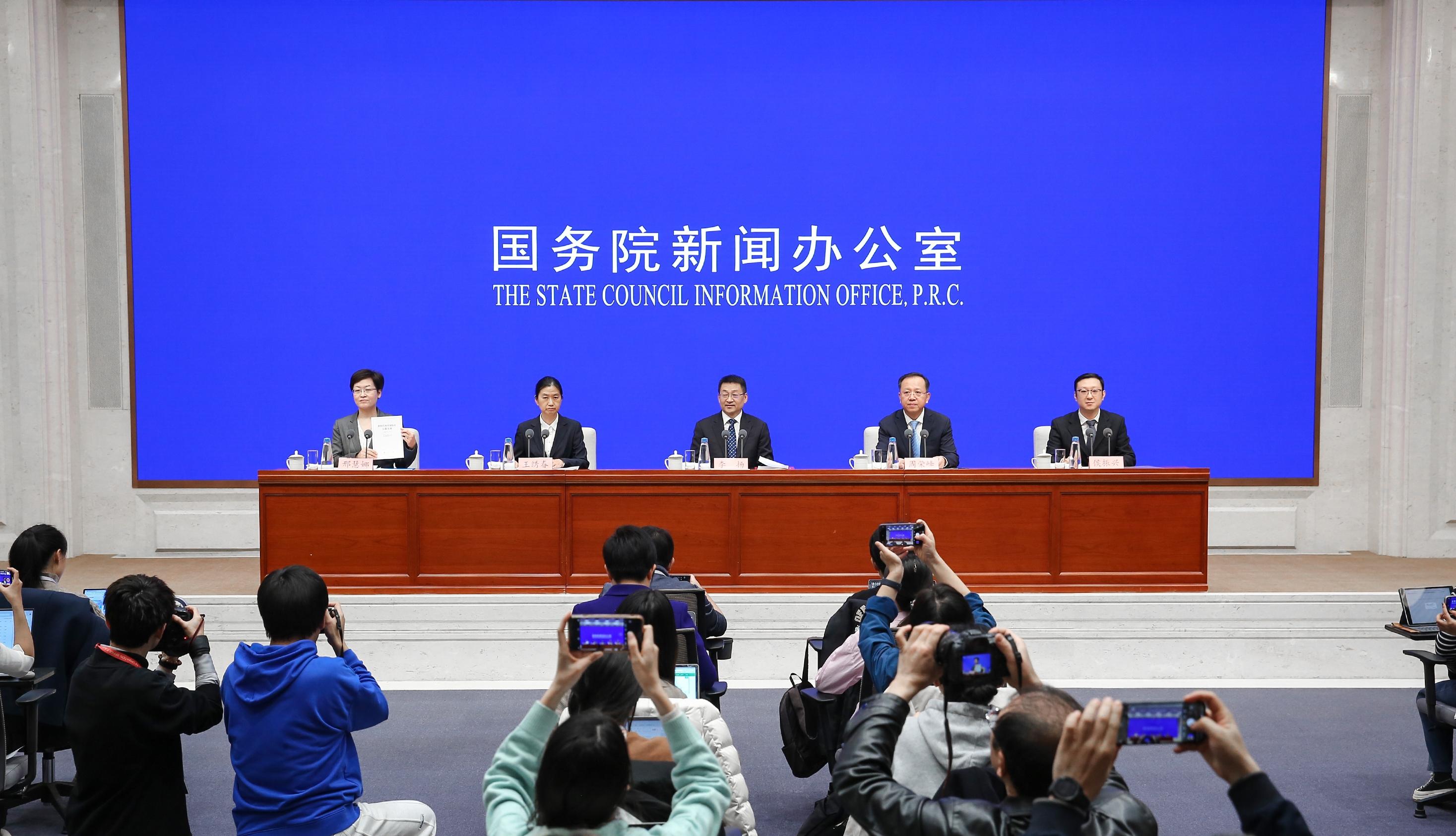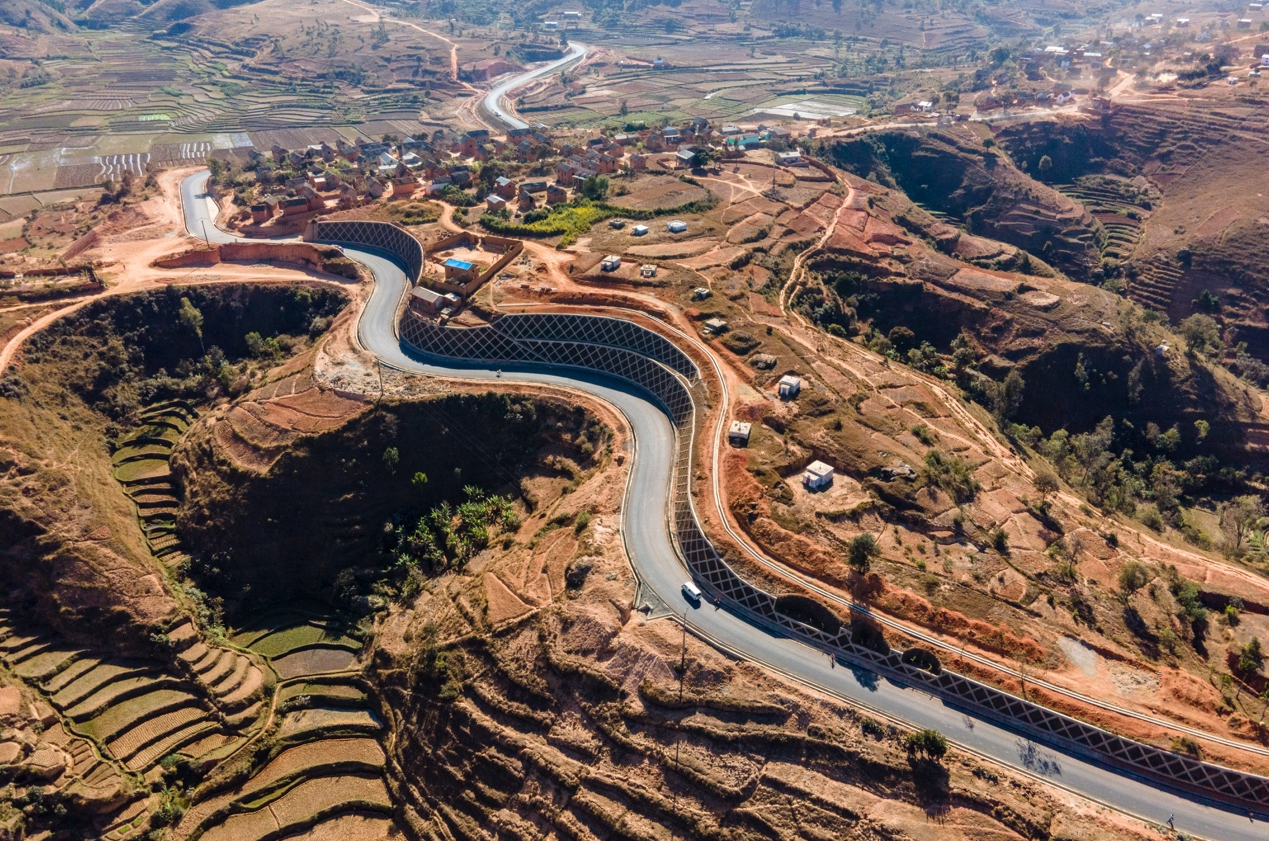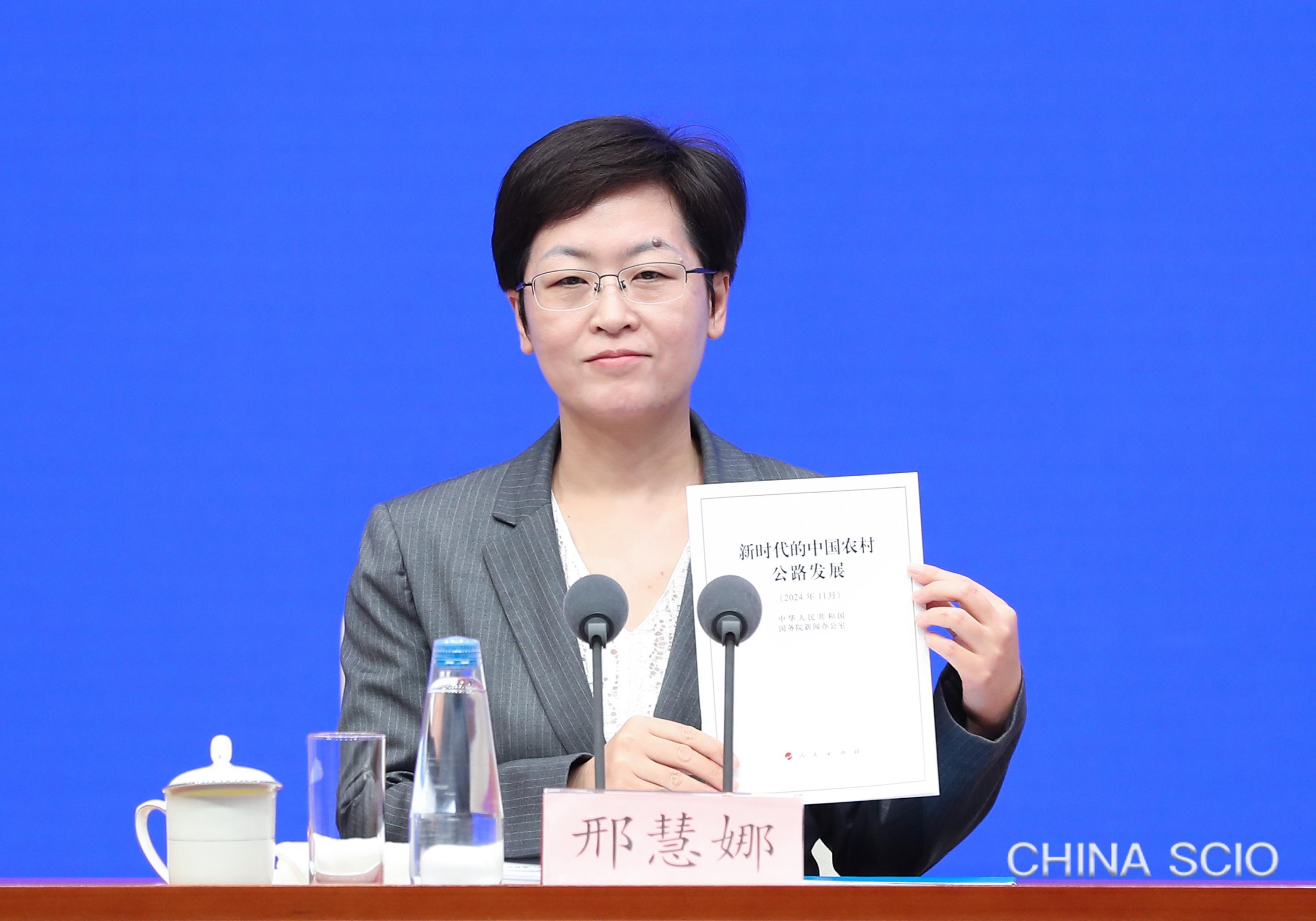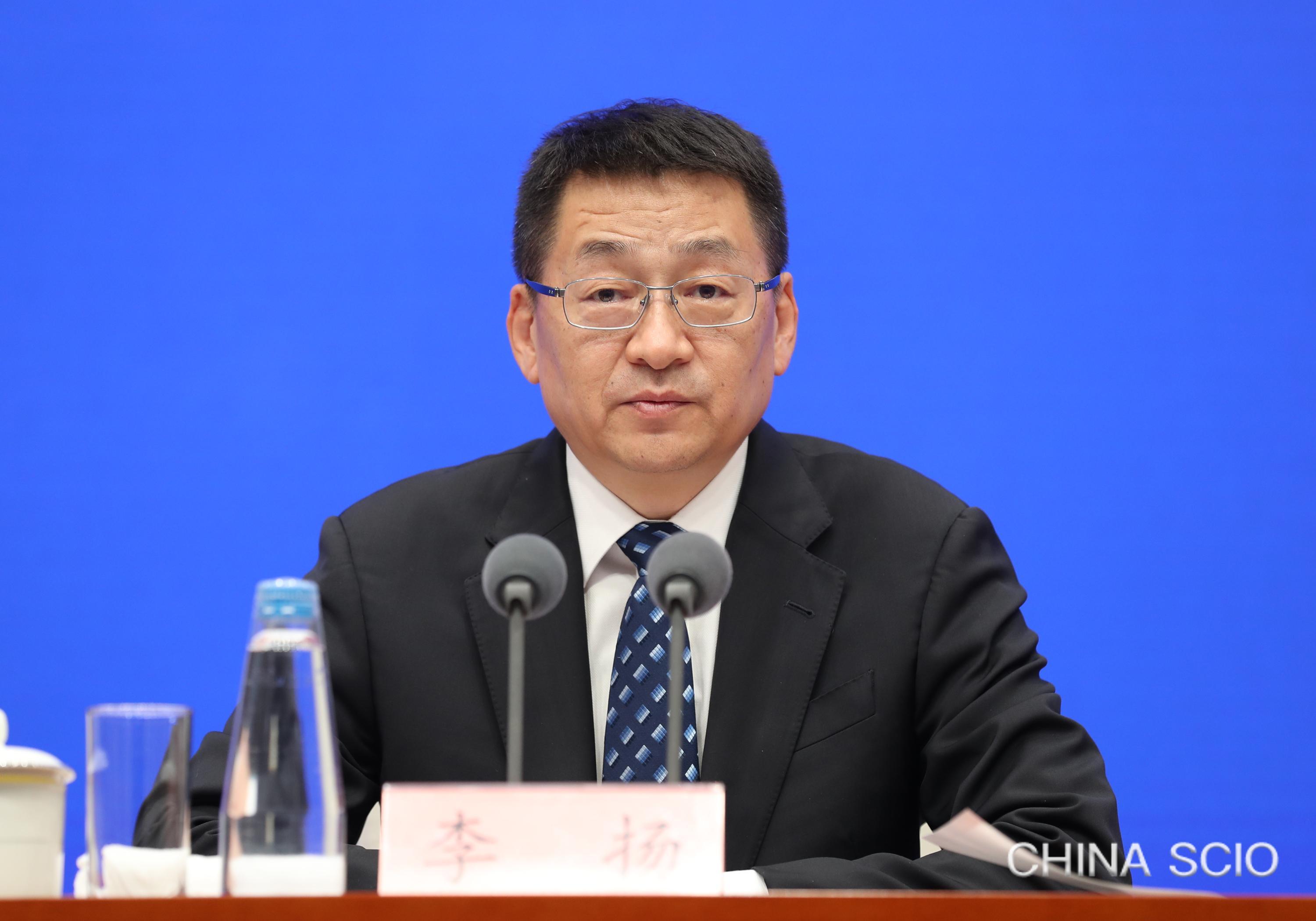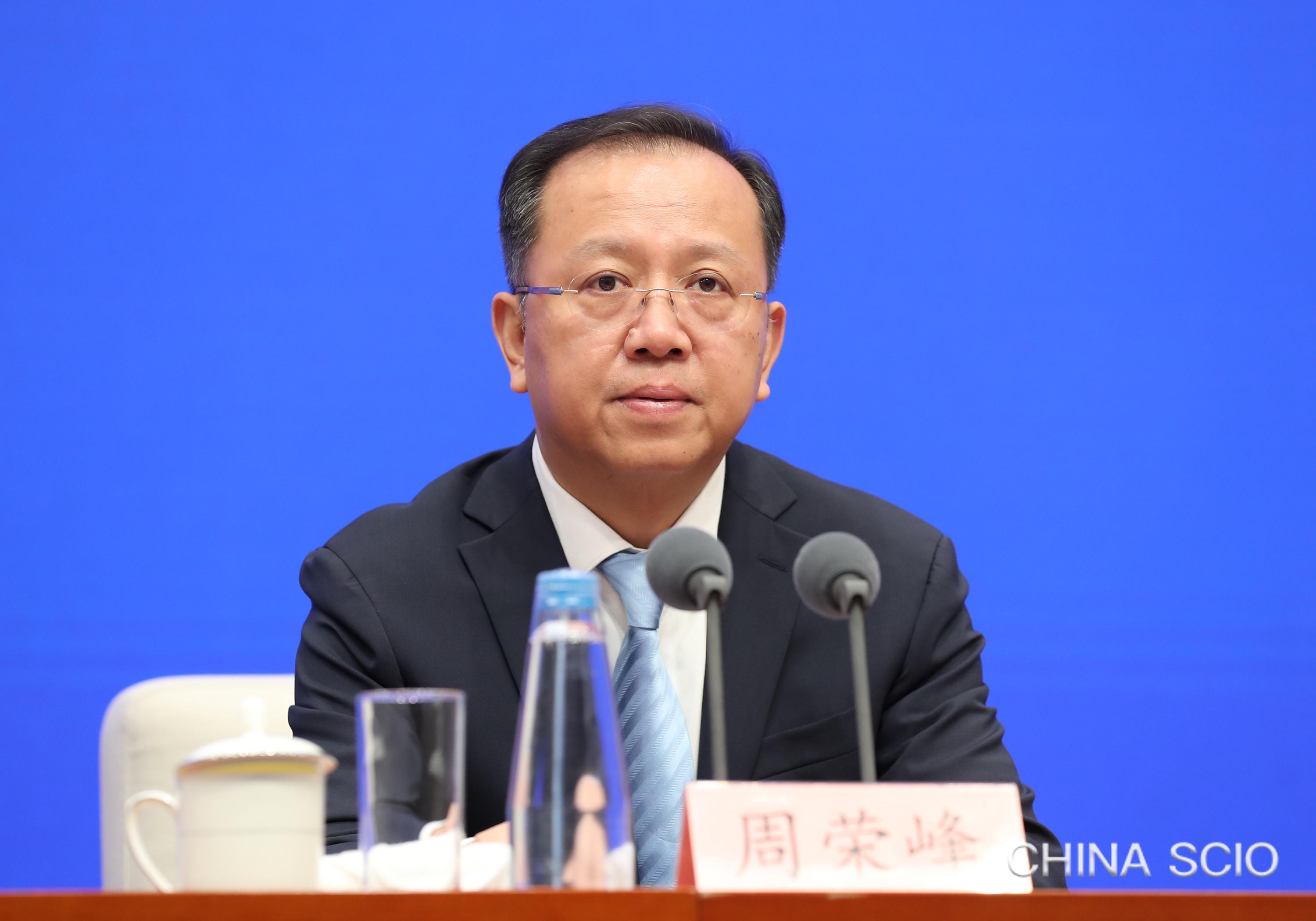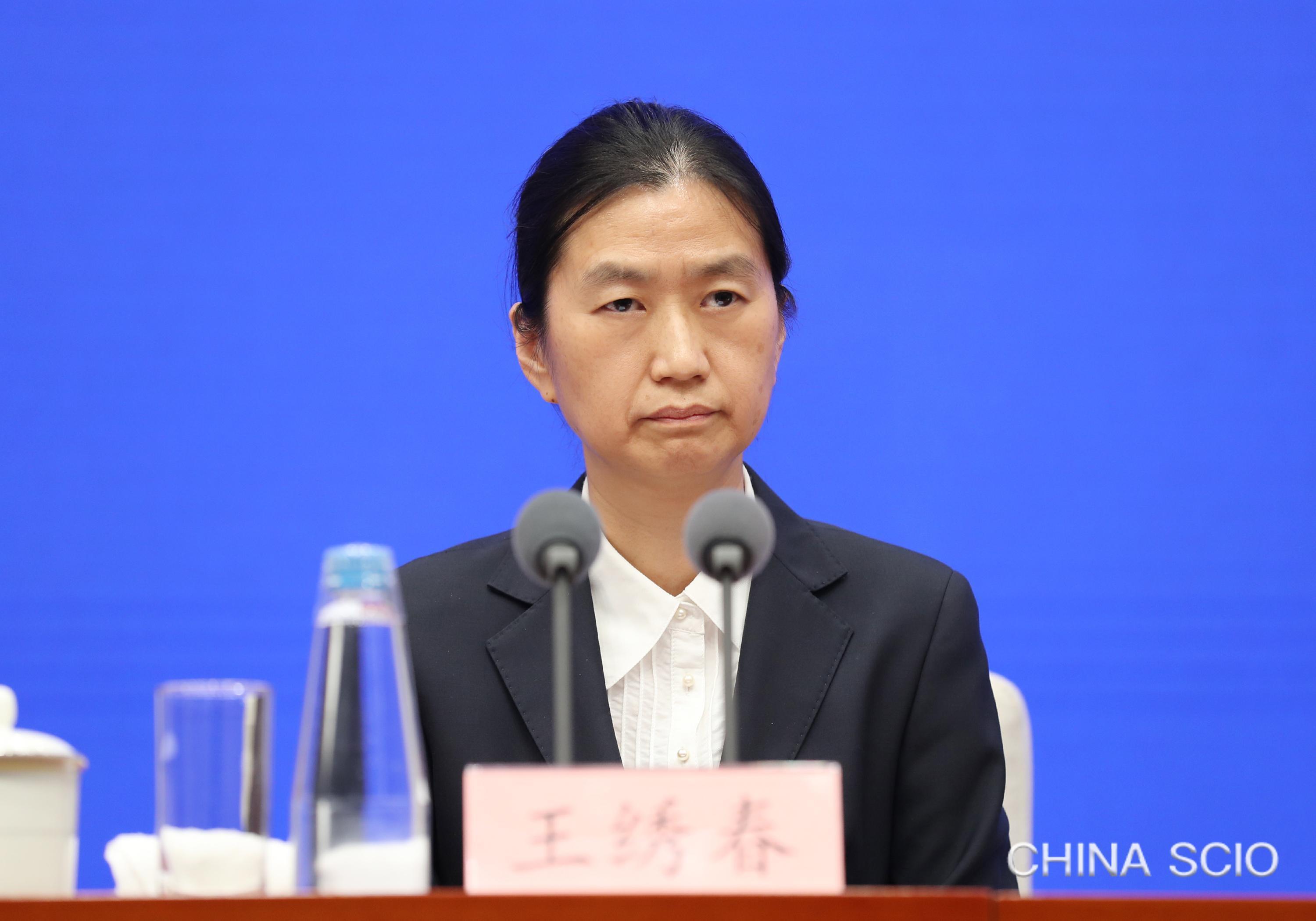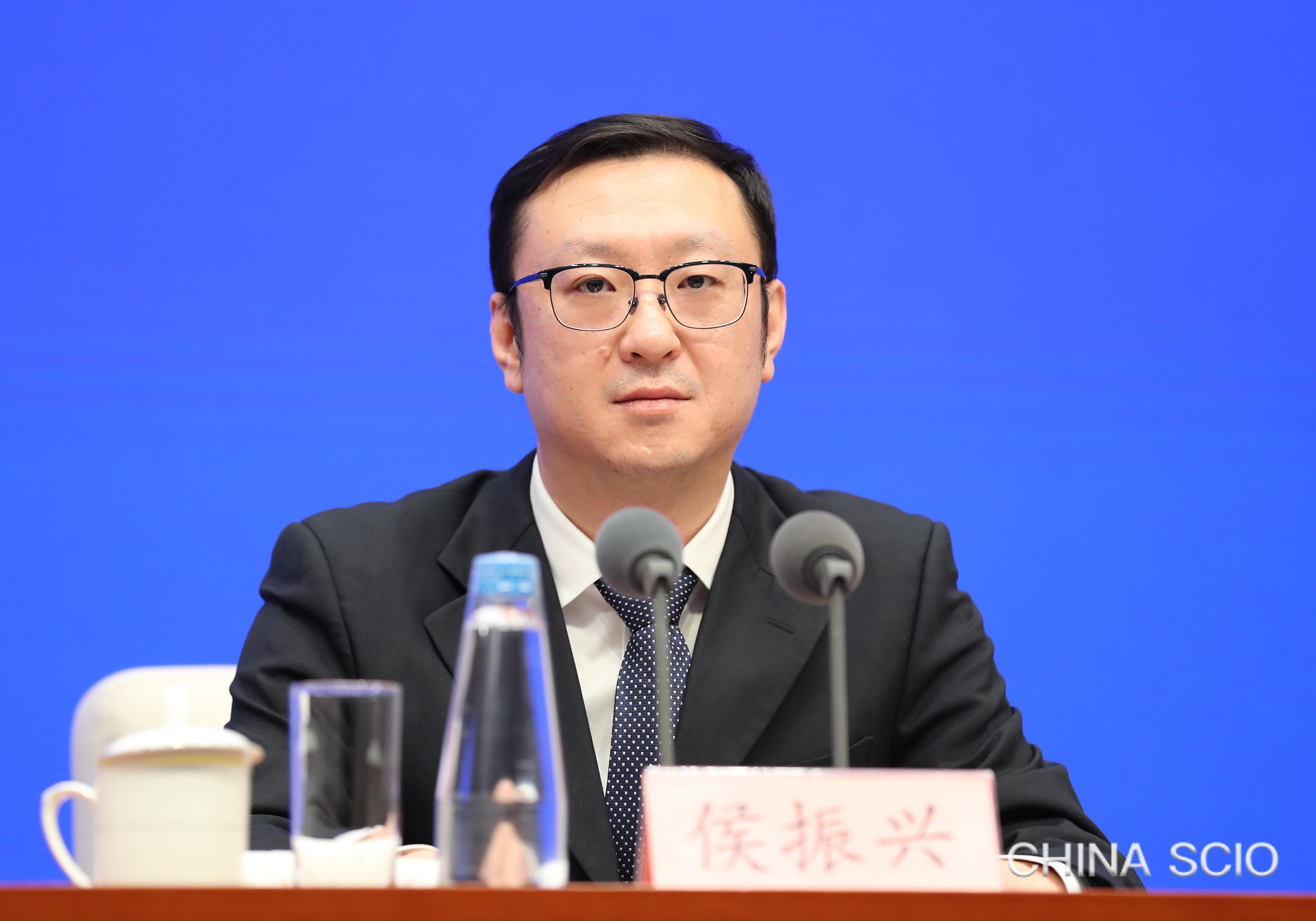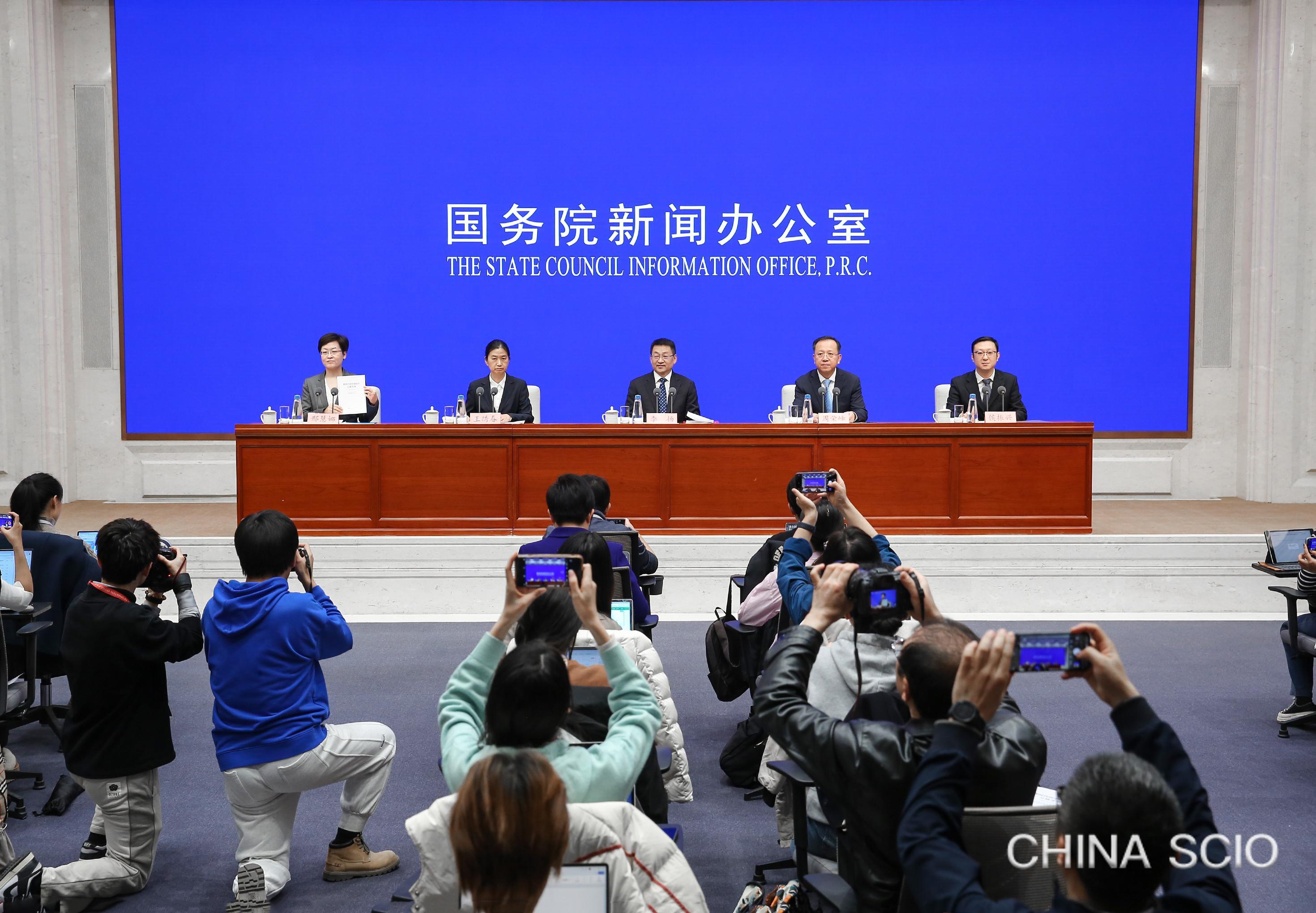Read in Chinese
Speakers:
Mr. Li Yang, vice minister of transport
Mr. Zhou Rongfeng, director general of the Highway Bureau of the Ministry of Transport
Ms. Wang Xiuchun, deputy director general and first-level inspector of the Department of Transport Services of the Ministry of Transport
Mr. Hou Zhenxing, deputy director of the General Planning Department of the Ministry of Transport
Chairperson:
Ms. Xing Huina, deputy director general of the Press Bureau of the State Council Information Office (SCIO) and spokesperson of the SCIO
Date:
Nov. 29, 2024
Xing Huina:
Ladies and gentlemen, good afternoon. Welcome to this press conference held by the State Council Information Office (SCIO).
Today, the SCIO has organized this press conference to release the white paper "China's Rural Roads in the New Era," and to introduce and interpret its main content. Guided by Xi Jinping Thought on Socialism with Chinese Characteristics for a New Era, the white paper fully implements General Secretary Xi Jinping's important instructions on the construction, management, maintenance and operation of rural roads. It systematically outlines China's policy approaches to rural road development and provides a comprehensive overview of efforts to steadily advance rural transport infrastructure construction, enhance governance capacity, improve maintenance efficiency, and elevate service levels. The white paper also shares China's experiences in supporting rural economic development, advancing rural revitalization, and promoting the modernization of agricultural sector and rural areas through rural road development. Furthermore, it highlights China's active contributions to the development of rural transport in other developing countries through international cooperation mechanisms, offering both wisdom and strength to foster global progress.
The white paper consists of a preface, main body and conclusion, and is approximately 20,000 Chinese characters in length. The main body is divided into seven chapters: "Building Roads to Benefit Rural Areas and the Rural Population," "Building Rural Roads Accessible to Every Household," "More Coordinated, Standardized and Efficient Rural Road Governance," "Safer, More Durable, and More Comfortable Rural Roads," "Smooth and Convenient Passenger and Freight Transport in Rural Areas," "Interconnected Roads Bring Prosperity to All Industries, and Help Improve People's Lives and the Environment in Rural Areas," and "China's Contribution to Rural Transport in Other Developing Countries."
The white paper is published in eight languages — Chinese, English, French, Russian, German, Spanish, Arabic and Japanese. It is published by the People's Press and the Foreign Languages Press and available at Xinhua Bookstores nationwide.
To help everyone gain a better understanding of the white paper, we have invited Mr. Li Yang, vice minister of transport, to attend today's press conference. He will introduce the white paper and interpret its key contents, and answer your questions. Also present today are Mr. Zhou Rongfeng, director general of the Highway Bureau of the Ministry of Transport; Ms. Wang Xiuchun, deputy director general and first-level inspector of the Department of Transport Services of the Ministry of Transport; and Mr. Hou Zhenxing, deputy director of the Department of General Planning at the Ministry of Transport. Now, I would like to invite Mr. Li to give his introduction.
_ueditor_page_break_tag_
Li Yang:
Ladies and gentlemen, friends from the media, good afternoon. I am very pleased to join you today to witness the release of the white paper "China's Rural Roads in the New Era." Thank you all for your interest in and support for the development of rural road infrastructure.
This year marks the 75th anniversary of the founding of the People's Republic of China, as well as the 10th anniversary of General Secretary Xi Jinping's important instruction to further improve the construction, management, maintenance and operation of rural roads. Guided by General Secretary Xi Jinping's important directives on rural roads, people of all ethnic groups in China have overcome mountains by building roads, crossed rivers by building bridges, and tackled difficulties, continuously promoting the high-quality development of rural roads. This has led to historic achievements and paved a development path for rural roads that is in line with China's national conditions, adapted to local conditions, and is practical. It has also contributed Chinese wisdom to the global poverty reduction cause and provided Chinese solutions. I will now briefly introduce the main contents of the white paper "China's Rural Roads in the New Era" from four aspects.
One aspect of the white paper is that it systematically expounds on the basic principles of China's rural road development. These basic principles can be summarized in five aspects:
First, people-centered approach. We remain committed to the development philosophy that prioritizes the people and focuses on their well-being, striving to meet the public's demand for better travel.
Second, high-level planning as a part of overall national development. We have focused our efforts on serving the central task of economic development and the overall interests of the country, positioning rural road development within major tasks that are crucial to the country's overall development, including poverty alleviation, the implementation of the rural revitalization strategy, and the modernization of agricultural sector and rural areas.
Third, exploring development paths in light of local conditions. We have taken into account the development stage and conditions of rural areas in different regions and of different types, and formulate differentiated development goals and supportive policies to ensure that rural roads align with the regional economic development level, rural industrial layout and the public's demand for safe, efficient and convenient travel.
Fourth, propelling rural road construction with reform and innovation. We continue to deepen the institutional reform of rural road management and maintenance systems, using reform and innovation to invigorate the development of rural roads.
Fifth, forging synergy for development through coordination and collaboration. We continue to motivate all parties involved, establishing a work framework under which Party committees exercise leadership, governments play a principal role, government departments across different levels coordinate their actions to ensure efficient operation, thus creating a powerful force for development.
The second aspect of the white paper is that it provides a comprehensive introduction to the practices and achievements in China's rural road development. Based on the foundation of "construction," we have accelerated the creation of an extensive rural road network that connects villages and towns. Over the past decade, we have constructed and upgraded 2.5 million kilometers of rural roads. By the end of 2023, the total length of rural roads in China reached 4.6 million kilometers, with all towns, townships, and administrative villages where conditions allow now having access to asphalt and cement roads. A rural transport infrastructure network in which county roads connect rural and urban areas, township roads crisscross, and village roads facilitate travel between households and farmland is in place. Our rural roads are not only built quickly but also beautifully. Every year, we select the top 10 most beautiful rural roads. Recently, in coordination with the white paper, we published a book titled "Rural Roads in China." I would like to recommend this book to all the journalists here. In it, you can explore many of China's most beautiful rural roads. We also welcome friends from the media to visit these roads, experience the beauty of China's countryside, and feel the rich and diverse rural culture.
By taking "effective management" as a means, we have accelerated the establishment of a standardized and efficient rural road governance system. In the white paper, we further summarize how to improve governance and management effectiveness, promote the rural road management system, improve laws and regulations, and issue guiding policy documents, especially technical standards. We have fully implemented the road chief system for rural roads, which has become well-known to everyone. This system aims to drive continuous improvements in the rural road governance framework.
Taking maintenance as the guarantee, we have accelerated the development of an applicable and diverse rural road management and maintenance system. We are not only focused on building roads, but also on maintaining them. Grasping key areas such as improving road conditions, ensuring safety and enhancing the roadside environment, we continuously strive to improve management and maintenance efficiency. The white paper includes a special section showcasing the progress in improving the proportion of rural roads classified as premier, good or medium condition. Over the past decade, this rate has increased by 10 percentage points, effectively realizing the principle of "every road must be maintained, and maintenance must be effective."
Taking good operation as the goal, we have accelerated the improvement of a convenient and balanced rural transport service system. The purpose of building roads is to better facilitate travel for rural residents. Guided by this goal, we have enhanced equal access in urban and rural transport services, promoted the integrated development of passenger, freight and postal services in rural areas, and facilitated the smooth flow of people and goods between urban and rural areas, as well as among townships. This has played a crucial role in enabling the equal exchange of production factors between urban and rural areas and balanced allocation of public resources.
The third aspect the white paper highlights is China's contributions to the development of rural roads in developing countries through promoting technical standards, sharing development experiences, and supporting local rural road construction. First, we have continuously expanded the availability and application of foreign-language editions of China's highway engineering standards, allowing more of the international community to understand China's road standards, particularly for rural roads. Second, we have established international exchange and cooperation platforms, actively participated in the work of international organizations, and conducted international training programs to share and exchange experiences in rural road development. Third, we have participated in international construction projects. For instance, a special section in the white paper introduces China's support for Ecuador's Ministry of Transport in post-disaster reconstruction. Through construction projects like these, along with technical support and human resources, we are helping developing countries to improve their rural transportation conditions.
The fourth aspect of the white paper is that it articulates China's firm stance on working with all countries to continue promoting global rural road development and poverty reduction.
These are the key points of the white paper that I wanted to introduce. Thank you.
_ueditor_page_break_tag_
Xing Huina:
Thank you for your introduction, Mr. Li. We will now move on to the Q&A session. Journalists are welcome to raise their hands to ask any questions. Please identify your news outlet before asking your question.
CCTV:
During the introduction, you mentioned that this year marks the 10th anniversary of the high-quality rural roads initiative, focusing on the construction, management, maintenance and operation of roads. Could you share the specific measures China has implemented over the past decade to advance rural road development? Thank you.
Li Yang:
Thank you for your question and for your interest in rural roads. Indeed, over the past decade, we have accumulated some valuable experience in promoting rural road construction. Our main practices can be summarized in eight aspects:
First, focusing on strengthening organization and leadership. The Ministry of Transport set up a leading group to implement the rural revitalization strategy and advance the high-quality rural roads initiative, integrating the construction of high-quality rural roads into practical matters that are closely aligned with people's livelihoods in transportation to ensure effective implementation. For 10 consecutive years since 2015, we have held national conferences on this topic, continually driving high-quality rural road development.
Second, improving policy systems. We have issued a series of guiding policy documents at the national level, such as the Guiding Opinions on Promoting the High-Quality Development of Rural Roads in Their Construction, Management, Maintenance and Operation, creating a comprehensive policy system on rural roads. Currently, 16 provinces, municipalities and autonomous regions have enacted local regulations for rural road development, laying a solid legal foundation for rural road development.
Third, enhancing financial support. As I mentioned, we have mobilized resources of all parties to create synergy for development, particularly in raising funds. Over the past decade, the central government has allocated 746.1 billion yuan in vehicle purchase tax funds for rural roads, primarily targeting impoverished areas. Nationwide, a total of 4.3 trillion yuan has been invested in rural road fixed assets, forming a fund guarantee system for rural road development centered on public finance with multi-channel supplementary sources.
Fourth, refining technical standard systems. We have emphasized tailoring construction standards to local conditions, issuing documents like General Specifications for Design of Low Volume Rural Highway Engineering, Technical Standards for Low Volume Rural Highway Engineering, and Technical Specifications for Maintenance of Rural Highways. These standards provide strong technical support for the high-quality rural roads initiative.
Fifth, deepening reform and innovation. We have implemented the Opinions of the General Office of the State Council on Deepening Rural Road Management and Maintenance System Reform, with 100% of provinces having now formulated provincial-level implementation plans. Additionally, 167 pilot units have been selected to explore reforms and form replicable and scalable experiences.
Sixth, strengthening the fulfillment of duties. We have reinforced the responsibilities of county-level governments, establishing a road chief system characterized by Party committee leadership, government guidance, departmental collaboration, multi-level coordination and efficient operation.
Seventh, highlighting models and leading practices. By creating national model counties for the high-quality rural roads initiative, promoting rural logistics service brands, establishing demonstration counties for integrated urban-rural transportation, and launching campaigns like the "Most Beautiful Rural Roads" and "Outstanding Road Workers" I just mentioned, we have advanced rural road improvement through exemplary practices.
Finally, adhering to integrated development. We have integrated the high-quality rural roads initiative into broader rural development ecosystems, including industries, logistics, the environment and economy with distinctive features, promoting the integrated development of passenger, freight and postal services. I have visited many counties and villages in China and witnessed how the integrated development of passenger, freight and postal services has transformed rural transportation. Local specialty agricultural products are promoted through online sales channels, including livestream e-commerce. This approach effectively integrates rural road development with transportation, tourism, ecological conservation and economic growth, significantly boosting farmers' incomes and prosperity. We are actively advancing the "Rural Roads +" model to support and drive comprehensive rural revitalization. This approach highlights the pivotal role of transportation as a frontier in Chinese modernization.
That is all from me. Thank you.
_ueditor_page_break_tag_
China Daily:
The white paper mentions the critical role of rural roads in poverty alleviation and supporting work relating to agriculture, rural areas and rural residents. Could you elaborate on this? Thank you.
Li Yang:
Thank you. I would like to invite Mr. Hou to answer this question.
Hou Zhenxing:
Thank you for your question. General Secretary Xi Jinping has emphasized that the high-quality rural roads initiative has brought vitality and prosperity to rural areas, particularly impoverished regions, while winning public support at the grassroots level for the Party. In recent years, the initiative has achieved remarkable results, enhancing rural residents' sense of gain, happiness and security. Rural roads have become pathways to prosperity, happiness, connection and revitalization for the people.
With the view to better serving the core task of economic development and the overall interests of the country, we have given full play to the foundational role of rural roads and expedited the development of rural transportation in poor areas. Since 2014, more than 1.4 million km of rural roads have been built or upgraded in previously poor areas, with more than 45,000 towns, townships and administrative villages obtaining access to bus services. All towns, townships and administrative villages where conditions allow had paved roads by 2019, and all such villages acquired bus services by 2020, fulfilling the promise that no region would be left behind because of inadequate transportation options on the journey towards prosperity. Our efforts can be summarized in three key points:
First, we have constructed better rural roads. After years of effort, we have built a rural transportation infrastructure network that connects villages, towns and townships, establishing an inclusive and equitable rural transportation service system. By doing so, we have ensured more comfortable and smoother passenger and freight transportation in rural areas, historically solving the problem of difficult road access in rural areas.
Second, we have made the countryside more beautiful. We have constructed high-quality rural roads that "are properly built, managed, maintained and operated," connecting urban and rural areas, shortening distance and travel times, as well as making efficient use of distinctive cultural and tourism resources in rural areas. By doing so, we have ensured that the vast countryside is finding greater prosperity and becoming more attractive, creating stronger momentum for rural revitalization. Such high-quality rural roads have also helped to improve the layout of villages and townships, retain local charm and nostalgia, enhance social etiquette and civility, bring significant changes in rural areas, and create a beautiful and harmonious countryside where people want to live and work.
Third, people who reside in rural areas have become better off. The steady improvement of transportation facilities in rural areas has attracted more capital, projects and talent to the countryside, creating more job opportunities and broadening avenues for income growth. People are now living a more prosperous life, bringing them closer to the Party. Through rural road construction projects, local governments have guided people who reside in rural areas to find jobs closer to their homes and to boost their incomes. As a result, high-quality rural roads have truly become projects that improve people's lives and win over people's hearts. Thank you.
_ueditor_page_break_tag_
21st Century Business Herald:
Roads should be well-built and maintained. In response to the problems of insufficient funds for rural road maintenance and difficulties in management, what measures has the MOT taken to ensure the long-term sound operation of rural roads? Thank you.
Li Yang:
Thank you. I would like to invite Mr. Zhou to answer your question about the funding for rural road maintenance.
Zhou Rongfeng:
Thank you for your question. We often say, "A well-functioning road network relies 30% on construction and 70% on maintenance." This speaks volumes about the importance of rural road maintenance. After years of continuous effort, we have had a good report card in this regard. The proportion of rural roads classified as premier, good and medium has been raised from 79% at the end of 2013 to 91.1% at the end of 2023. Over the years, we have continuously increased investment in rural road maintenance as well as have explored and applied new models and technologies. Mainly, we have made efforts in the following few aspects:
First, we have improved the system of standards and specifications for rural road maintenance. We have officially launched a range of technical standards and specifications, including Technical Specifications for Maintenance of Rural Highway, Standards for Rural Highway Condition Assessment and Budget Compilation Method for Rural Road Maintenance. By doing so, we have established a system for technical standards that adapt to the current stage of rural road development. At the same time, we have guided local governments in implementing road maintenance projects covering regular maintenance, preventative maintenance, repair maintenance, specialized maintenance and emergency maintenance. All these efforts have clarified the content and requirements with maintenance work and have made our work more standardized and specialized.
Second, we have further guaranteed sufficient funding for rural road maintenance. Based on factors such as road length and changes with maintenance costs, we have set up a mechanism for making dynamic adjustments to subsidy policies related to regular rural road maintenance. We have also increased the portion of fuel oil tax revenue that is allocated for subsidies with rural road maintenance. Subsidies granted to local governments for phasing out tolls on government-financed Grade II highways have been provided as a type of reward for good local performance with supporting rural road maintenance. We have guided local governments to make the best of policies with transfer payments for equalizing access to basic public services as well as with tax rebates. We have also actively explored the way to bundle rural road maintenance projects with profitable projects like some supporting facilities. All these efforts have introduced new fundraising methods and have expanded financing channels. In addition, to support rural road maintenance, we have incorporated road management and maintenance in the procurement services guidance catalog and have explored mechanisms such as disaster insurance for rural roads.
Third, we have promoted scientific decision-making for road maintenance. We have strengthened the application of information technology and have promoted digital transformation, integrating scientific decision-making into the entire process of rural road maintenance. We have actively promoted new technologies, techniques, materials and equipment in rural road maintenance, applying R&D efforts to automatic vehicles and portable devices to examine road surface conditions. By doing so, we have moved faster to promote the automatic examination of rural road conditions, as well as have strengthened data analysis and application, offering data support for scientific decision-making.
Fourth, we have created new organizational models for road maintenance. We have systematically advanced market-oriented reform of rural road maintenance and have recruited professional companies to provide maintenance services, improving the specialization, mechanization and scale of maintenance operations. Meanwhile, we have strengthened technical training for rural road employees, effectively combining general and professional maintenance. Novel organizational models of rural road maintenance have been encouraged, such as combined tendering for the construction and maintenance of trunk highways and rural roads, overall contracting for zonal maintenance of rural roads as well as combined tendering for rural road construction and maintenance. All these efforts have made rural road maintenance operations more specialized.
Thank you.
_ueditor_page_break_tag_
China Financial and Economic News:
As the key infrastructure connecting urban and rural areas, rural roads are indispensable for promoting rural economic development and improving people's well-being. What are your considerations and major tasks for the future in regards to promoting the high-quality development of rural roads? Thank you.
Li Yang:
Thank you for your question. Looking from the point of view based on our endeavors to develop rural roads, most of the road network has already been completed. Next, as the journalist just mentioned, we will enter a new stage of high-quality development. Now, we are taking comprehensive moves to implement a rural revitalization strategy. Rural roads are a major infrastructure that promote common rural prosperity, advance rural revitalization across the board as well as expedite the modernization of agriculture and rural areas. On the new journey of the new era, we should continue to make sustained efforts. One of my colleagues just mentioned that rural roads have become projects that improve people's lives and win over people's hearts. To fully implement these projects, we will take efforts in three aspects to launch a new round of programs focused on the upgrading of rural roads.
First, enhancing service support for the comprehensive vitalization of rural areas. Through the construction of rural roads, including services, we aim to promote the enhancement and integrated development of our industries. We plan to focus on upgrading the main rural road network to Grade III standard or higher, creating fast access routes that connect townships and major economic nodes. We will vigorously develop the "Rural Road Plus" model, accelerating the construction of roads for rural industries, tourism and resources. This effort will further deepen the integration of transportation with the tourism and energy sectors. We will also enhance the construction of "Beautiful Rural Roads," coordinating the development of rural roads, optimizing village layouts, and improving the rural living environment.
Second, ensuring safety and securing the baseline. Safety is the primary task in promoting the development of rural roads. We focus on providing paved roads to larger natural villages and graded roads to administrative villages, accelerating the renovation of old roads and the widening or creation of passing lanes on overly narrow rural roads. In the past, some rural roads were built so narrow that vehicles could not pass each other, sometimes making travel difficult, but now rural transportation is developing rapidly. We will strengthen the inspection and rectification of potential risks and hidden dangers in rural roads, bridges and tunnels, while accelerating the enhancement of safety protection capabilities. We will increase investment in maintenance, advance rectification projects for substandard road sections, and steadily improve the road service.
Third, striving to improve service quality and increase public satisfaction. With the increasing use of new energy vehicles on rural roads and changes in travel modes, we will focus on enhancing the construction of service facilities along rural roads. We aim to further expand services such as parking, shopping, tourism and charging, to promote the equalization of urban and rural passenger transport services. We will further optimize rural logistics services and improve the integrated development of passenger, freight and postal services in rural areas. We will further promote work--relief programs in the construction and maintenance of transportation infrastructure, directly creating more job opportunities. We will make coordinated use of public welfare positions in the management and maintenance of rural roads, creating more opportunities for employment and income generation for rural residents along these routes. This will continuously enhance the sense of gain, happiness and security among the vast rural population.
That is all from me. Thank you.
_ueditor_page_break_tag_
Phoenix TV:
We are particularly interested in the support of transportation in rural areas. As we continue to build the rural road network, how can the transportation support services be improved in rural areas? Thank you.
Li Yang:
Thank you for your question. I would like to invite Ms. Wang to answer this.
Wang Xiuchun:
Thank you for your interest in transportation services. Over the years, we have continuously strengthened the rural road network. We have focused on improving transportation services in rural areas from the perspectives of both passengers and freight, constantly perfecting our service network, improving our service system and enhancing service quality.
In terms of rural passenger transportation, we have taken three major steps to address the travel needs of rural residents. First, we have aimed to ensure accessibility. By developing urban-rural bus services, passenger transport routes and customized passenger services, we have extended the rural passenger transport network. As my colleague mentioned earlier, by 2020, all townships and administrative villages that meet certain conditions had access to bus services. Over the past decade, more than 45,000 new administrative villages have been connected by bus services. Second, we have focused on retention. As the public now has more travel options, the passenger flow in rural transportation has significantly decreased, making stable operations challenging. We have continuously optimized management policies and adjusted subsidy methods to promote the integration of rural passenger transport with related industries, ensuring sustainable and stable operations. Third, we have strived for quality connectivity. We have encouraged rural passenger transportation companies to innovate service models, operate market-day and busy-season routes, and implement integrated urban-rural public transportation, catering to the diverse travel needs of rural residents. Additionally, various service outlets have been set up in passenger transport stations, expanding services such as parcel collection and delivery, financial telecommunications, and e-commerce exhibition sales, providing comprehensive and diverse services to rural residents.
In rural freight logistics, we have focused on three main areas to address the development bottlenecks in rural logistics. First, we have aimed to expand coverage. We strongly support the construction of rural logistics nodes, continuously improving the network system and service functions to build the "core strength" of rural logistics development. Second, we have created new models. Supporting local efforts to explore ways of development based on unique regional advantages, we have now established over 150 rural logistics service brands with demonstrative significance, achieving integrated development of rural logistics, industry and e-commerce. Third, we have cultivated strong entities. We guide leading logistics companies to accelerate the expansion of service networks in rural areas, promote the integration of market resources, and build a shared distribution system, reducing end-stage delivery costs in rural areas by about 15% in provinces like Zhejiang, Hunan and Sichuan through successful explorations and trials.
Next, we will continue to monitor the evolving needs of rural transportation services, implement multiple measures and consistently enhance the quality and efficiency of these services, helping rural areas achieve the vision of "smooth and convenient passenger and freight transport" sooner. Thank you.
_ueditor_page_break_tag_
National Business Daily:
We know that there are still some disparities in development levels between different regions in our country. What targeted measures have been taken to improve transportation conditions in ethnic minority regions, remote mountainous areas and impoverished areas? Thank you.
Hou Zhenxing:
Thank you for your question. Transportation in ethnic minority regions, remote mountainous areas and impoverished areas mainly relies on roads. Therefore, in promoting the development of rural roads, we always adhere to the people-centered development philosophy, implement precise policies, focus on balanced development, and explore rural road development models suitable for different regions based on local resources. We have taken three main targeted measures:
First, we have formulated differentiated policies and increased support. Based on the characteristics of the central and western regions and areas with special difficulties, we determine different construction priorities, formulate differentiated investment policies, and provide preferential support. We focus on developing rural roads in poverty-stricken counties, key counties for rural vitalization, underdeveloped areas, mountainous areas and ethnic minority regions, rapidly addressing shortcomings to promote balanced development of regional rural roads.
Second, we have adopted special measures to solve travel difficulties. To ensure safe travel for residents in remote areas, we have developed special plans and advanced the construction of rural roads in areas where "ethnic groups skip development stages to directly enter socialist society" and in ethnic minority areas with smaller populations to help these ethnic groups escape poverty. Additionally, for some mountainous areas where zip lines are significant safety risks and are inconvenient, we have implemented "replacing zip lines with bridges" projects, benefiting960,000 residents from 904 administrative villages, allowing them to enter a new "era of bridges."
Third, we have implemented a series of projects to improve the quality of roads. We have orderly implemented a series of projects, including building Grade III roads in towns and townships, providing paved roads to administrative villages, renovating roads with a shallow subgrade or surface, and renovating old county and township roads. These efforts have ensured that all 30,000 towns and townships and more than 500,000 administrative villages where conditions allow have been connected by paved roads. At the same time, we have developed models, such as "transportation + industry" and "transportation + tourism," tailored to local conditions. This has continuously improved the transportation network in rural areas, providing new momentum for rural revitalization and making travel more convenient for farmers in remote regions. Thank you.
Li Yang:
I want to add something. This journalist just mentioned the travel situations in ethnic areas, remote mountainous regions and poverty-stricken districts. Mr. Hou just touched on an initiative which replaces zip lines with bridges in some mountainous areas and remote regions and has benefited 904 administrative villages and 960,000 people. Many of you may have seen scenes of farmers using zip lines for transportation. Ten years ago, General Secretary Xi Jinping said a particularly moving thing: "Especially in some impoverished areas, replacing zip lines with bridges and building new roads can open the door to prosperity for people." Ten years ago, the general secretary's instruction kicked off the high-quality development of rural roads in their construction, management, maintenance and operation, which helped many villages say goodbye to the history of not having roads. Here, we also feel the great responsibility for future development and hope that journalists will pay more attention to these special regions and provide us with good advice and suggestions. Thank you.
_ueditor_page_break_tag_
Dingduan News:
In recent years, various regions have explored and practiced the integration of rural passenger transport, freight logistics and postal delivery, promoting the intensive development of rural transportation. Could you please briefly talk on what the current situation is with the integrated development of passenger transport, freight transport, and mail delivery in rural areas? What are the next steps to promote better integration of the three?
Li Yang:
Thank you for your questions. You just mentioned a very professional term: the integrated development of passenger transport, freight transport, and mail delivery in rural areas. I will ask my colleague, Ms. Wang Xiuchun, to answer.
Wang Xiuchun:
Thank you to this journalist for their attention to this topic. We have always regarded the integrated development of passenger transport, freight transport, and mail delivery in rural areas as an important measure to promote comprehensive rural revitalization, ensuring stable rural passenger transport, smooth logistics distribution, and effective handling of the "first and last mile" of postal services. After years of work, the integration of rural passenger, freight and postal services in China has gradually improved in terms of equipment, systems and operational mechanisms. As of now, more than 1,500 county-level administrative districts in the country have implemented the integration of rural passenger, freight and mail services, with more than 12,700 cooperative routes opened. In the first half of this year, the number of mail and express deliveries through rural passenger, freight and mail integration exceeded 900 million items.
We also see that in the process of rural passenger, freight and mail integration development, there are still issues such as insufficient coverage, imperfect cooperation mechanisms and lack of standardization in business operations. The next steps will focus on addressing these issues and accelerating the integrated development of rural passenger, freight and mail services.
First is the improvement of collaborative working mechanisms. Rural passenger, freight and mail integration development, as evidenced by the term, focuses on integration. We will guide local authorities to establish mechanisms for cooperation between transportation, postal, agricultural, rural and commercial sectors to form an efficient and collaborative working model.
Second is the improvement of service systems. We will guide local areas to continue improving the county, township and village-level service station systems, regulate rural passenger, freight and mail business practices, and expand new models such as "passenger, freight and mail + e-commerce, tourism and agriculture" to achieve sustainable development.
Third is the promotion and application of suitable equipment. We will strengthen communication with relevant departments and will continue promoting suitable vehicle models for rural passenger, freight and mail integration. We will encourage and guide county-level stations to adopt automated sorting and loading equipment to boost distribution efficiency.
Fourth is the continuation of improvements to support systems. We encourage localities to improve their supportive policies according to local conditions, to strengthen the promotion of successful experiences and to create a favorable atmosphere for the integration of rural passenger, freight and mail services throughout society. Thank you.
_ueditor_page_break_tag_
Economic Daily:
The white paper mentions that in the process of building and maintaining rural roads, many employment opportunities have been created for local farmers. Could you please elaborate on this? Thank you.
Li Yang:
Thank you to the Economic Daily reporter for their attention to the issue of employment. With the development of rural roads in China, we always emphasize people's collaboration, participation, and common interests, so that all the people can enjoy the benefits of better rural roads. In the construction and maintenance of rural roads, transportation departments at all levels have paid close attention to creating more direct employment opportunities for farmers. While indirect employment opportunities have greatly increased due to rural development and the integration with the tourism industry, we have also directly created jobs through the construction and maintenance of rural roads, allowing farmers to increase their incomes through employment close to their homes. Specifically, there are two main approaches:
First is the promotion of work-relief projects in rural road construction and maintenance to draw more rural labor. This is due to rural road construction and maintenance both requiring large investments, which benefits a wide range of people and has strong potential to drive up local employment. To facilitate employment absorption, we have issued the Notice on Doing a Good Job in Work-Relief in Transportation Construction and Maintenance and have encouraged and guided localities to actively promote work-relief programs. We also issued a tentative guideline for implementation of work-relief programs in transportation infrastructure construction and maintenance to further enhance technical guidance. Last year, we conducted a survey and found that 3,946 rural road projects adopted work-relief approaches, directly drawing nearly 96,000 rural laborers, which included nearly 14,000 people from once poverty-stricken households.
Second is the development of public welfare posts in rural road projects. Through taking advantage of the large number of widely distributed rural road projects, we have vigorously developed related jobs, which have played an active role in helping poverty alleviation as well as promoting common prosperity among rural residents. While increasing the number of positions for employment, we have also focused on enhancing skills training for the workforce, not only providing employment opportunities but also improving their skills to better meet job requirements. Currently, there are about 850,000 positions directly available in the field of rural road management and maintenance.
These are some of the practical experiences we have gained through the development of rural roads. We will encourage localities to explore more ways to continue creating both direct and indirect employment opportunities in line with the development of rural roads. Thank you.
_ueditor_page_break_tag_
Xing Huina:
Please continue to raise questions. I notice two journalists have their hands raised.
Haibao News:
The construction of rural roads has greatly improved road infrastructure for rural people. Could you share some good practices to ensure travel safety? Thank you.
Zhou Rongfeng:
Thank you for your question. Ensuring safer and more secure travel has always been our priority. To this end, we've intensified our efforts in recent years in the following three areas:
First, we have strengthened the safety of infrastructure. We have enforced a system for synchronizing the design, construction and the commissioning of road safety facilities with road construction projects. We have also taken solid actions to further refine the management of rural road safety facilities and traffic order. Moreover, we have prioritized rural road safety as a key component of our efforts to make transportation more people-oriented. We've also advanced the construction of the rural road travel safety project every year. Over the past decade, the rural road travel safety project has covered a total length of 1.23 million km. We have also made great efforts to refine safety facilities, including road signs, pavement markings, speed bumps and traffic lights, in a bid to improve rural road safety.
Second, we have carried out renovation and upgrading of bridges with poor technical conditions. We have made consistent efforts to strengthen bridge management and regular safety inspections for key bridges, and have implemented the 10 regulations for bridge operation safety, including strict accountability, the disclosure of information and funding guarantees. We also have carried out a series of special programs on the safety of highway bridge guardrails and the standardization of bridge information and bridge load limit signs for rural road transport. We have advanced actions to renovate old and dangerous bridges, prioritizing the repair of rural road bridges deemed to be dangerous. Over the past decade, a total of 58,000 old and dangerous bridges in the rural road network have been renovated; the total number of dangerous bridges has decreased on a yearly basis; the proportion of bridges that are in serviceable condition has increased from 83.2% to 98%.
Third, we have further improved disaster readiness and mitigation for rural road transport. We have released the Guidelines on Further Improving Disaster Readiness and Mitigation for Rural Road Transport and have strengthened public emergency management mechanisms for rural roads, enhancing disaster readiness and response capabilities of rural road networks. We have strengthened targeted inspections on key road sections during critical time periods and addressed rural road safety hazards. We have also made progress in establishing local reserve centers for highway emergency response supplies, enhancing the stockpiling capabilities for emergency response equipment, supplies and devices. We have built up rural road emergency rescue forces composed of both professionals and the general public, and have boosted their emergency response capabilities by intensifying drills for contingency plans, improving personnel training and increasing transport capacity.
By implementing the aforementioned measures, we have been able to continuously improve the safety and traffic conditions of rural roads. Thank you.
_ueditor_page_break_tag_
Xing Huina:
One last question, please.
Yicai:
Creating a beautiful and harmonious countryside that is desirable to live and work in is an important task in advancing the rural revitalization strategy. What is the role of rural roads in this process? Thank you.
Li Yang:
Thank you for your question. Creating a beautiful and harmonious countryside is a major strategic arrangement made by the CPC Central Committee. It represents a beautiful evolution of rural development. In the process of rural road development, we have made serving and supporting the building of a beautiful and harmonious countryside our priority. Specifically, we have taken efforts in the following areas:
First, we have focused on creating harmony between rural roads and their surroundings, including the layout of villages and towns, natural landscape and traditional culture. As mentioned previously, we have ensured rural road development in line with local conditions. In the planning, design and construction of rural roads, we've prioritized their integration into the optimization of the layout of villages and towns, improvement of rural living environments as well as the preservation of cultural relics and heritage, and surrounding landscape. We've also emphasized making rural roads blend in with their historical surroundings and cultural landscapes. Rural roads have played an important part in helping make the countryside more beautiful and preserve cultural traditions.
Second, we have intensified our endeavors to ensure improvements in road environment and service capacity. Local governments have launched projects to improve road environment, taking measures based on their own conditions to make rural roads tidy, green and beautiful. We have stepped up our efforts to separate roads from farmlands and residential housing, creating a beautiful environment for smooth, safe and comfortable travel, and building roads to make the countryside greener and more attractive.
Third, we have promoted the integrated development between rural roads and tourism. We've developed the model of "rural roads plus tourism," in which we connect rural roads with local cultural and tourist resources including natural landscapes and cultural heritage, turning scenic resources that have been preserved by generations of villagers into popular tourist destinations to boost rural revitalization through tourism. More examples like these can be found in the white paper. We also encourage you all to go experience this firsthand.
Moreover, we've launched diverse activities to help more people know "beautiful rural roads" and the beauty of the countryside. Since 2019, we have been launching the publicity activity themed "The road in front of my home," selecting the "Top 10 Most Beautiful Rural Roads" annually in a bid to highlight the remarkable progress and changes in rural road development. This activity has garnered widespread attention. This year, we worked with the Ministry of Culture and Tourism and the Office of the Central Cyberspace Affairs Commission to launch an activity that recommends the most beautiful routes for road trips. This event is designed to showcase the most picturesque rural roads, inviting people to discover and enjoy the beauty of the countryside during their time off.
We anticipate that these featured routes will soon evolve into must-visit tourist attractions, drawing crowds of social media influencers. After years of development, beautiful rural roads connect both natural and cultivated landscapes, blending in with distinctive rural homes as well as helping to build a large number of villages and towns that are desirable to live and work in, and painting new scenes of rural harmony and beauty.
Regarding the future development of rural roads, as I previously mentioned, the Ministry of Transport will continue to thoroughly study and implement the series of important instructions of General Secretary Xi Jinping regarding the construction, management, maintenance and operation of roads in rural areas, and will implement a new round of programs for rural road upgrading. We are aiming to make rural roads better, safer, more attractive and more convenient, ensuring that rural residents can fully benefit from the outcomes of reforms and development.
Last, I would like to take this opportunity to express my gratitude to you for your interest in rural road development. We also welcome your oversight as we strive to address any problems that may occur. Thank you.
Xing Huina:
Today's press conference is hereby concluded. Thank you to Mr. Li, all the speakers and our friends from the media. Goodbye everyone.
Translated and edited by Liu Caiyi, Huang Shan, Mi Xingang, Yuan Fang, Li Xiao, Ma Yujia, Yang Chuanli, Fan Junmei, Xiang Bin, Liu Sitong, Gong Yingchun, Zhang Junmian, Li Huiru, Jay Birbeck, David Ball and Rochelle Beiersdorfer. In case of any discrepancy between the English and Chinese texts, the Chinese version is deemed to prevail.
